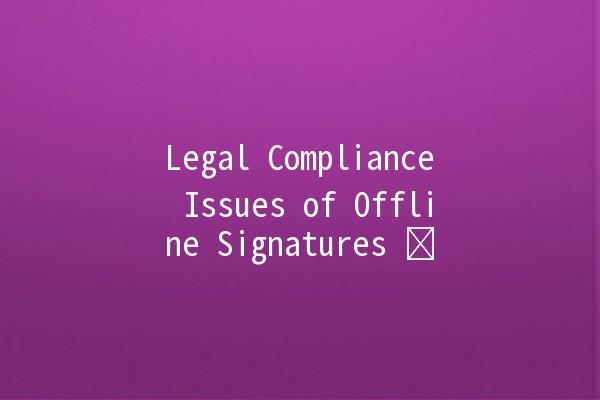
In our digital age, the need for legal documentation remains steadfast, even as more operations move online. One key area of legal documentation is signatures, specifically offline signatures. While online signatures have gained prominence due to their convenience, offline signatures still play a crucial role in many business transactions. Understanding the legal compliance issues surrounding offline signatures can help businesses navigate potential pitfalls and ensure that their transactions remain legally binding.
Understanding Offline Signatures
An offline signature refers to a handwritten or manually executed signature on a physical document, rather than an electronic one. This signature serves as an authenticating mark or endorsement by the signer, often indicating consent, approval, or acknowledgment of the terms of the document.
Legal Validity: The legal validity of offline signatures is grounded in various laws, including the Uniform Commercial Code (UCC) in the United States and similar legal frameworks worldwide. These laws recognize handwritten signatures as legally binding, provided that they are executed willingly by the signer.
Key Considerations:

Intent: The signer must clearly intend to sign the document.
Capacity: The individual must have the capability to understand the document and its implications.
Volition: The signature must be made voluntarily without coercion.
Legal Compliance Challenges
Despite the general acceptance of offline signatures, several compliance challenges can arise. Here are some critical areas for businesses to be aware of:
Challenge: Ensuring that the signed document remains unchanged after signing is crucial for maintaining its legal validity.
Solution: Implementing secure storage measures and utilizing tamperevident packaging can help preserve document integrity.
Challenge: Verifying the authenticity of a signature can be challenging, especially when disputing a signature's validity.
Solution: Utilizing additional identification methods, such as a notary public or witness signatures, can provide further verification and reduce disputes.
Challenge: Different jurisdictions have varying laws regarding the acceptance of signatures, especially in interstate or international transactions.
Solution: Researching and understanding local laws concerning signature requirements is essential for compliance.
Challenge: Businesses may face challenges in maintaining proper records of signed documents, leading to potential compliance issues.
Solution: Establishing a robust recordkeeping system that details where and how signed documents are stored will support compliance needs.
Challenge: Once a signature is affixed to a document, revoking that signature or modifying the document can present legal complications.
Solution: Including clauses in contracts that outline procedures for revocation or modification can clarify these aspects upfront.
Tips for Enhancing Productivity in Managing Offline Signatures
To ensure smooth operations regarding offline signatures, businesses can implement several productivityenhancing techniques:
Explanation: Develop a standardized process for handling documents requiring offline signatures. This includes templates and clear instructions for signers.
Example: A law firm could create a checklist to guide clients on how to execute and return signed documents correctly.
Explanation: Use project management software to track the status of documents that require signatures.
Example: A company could employ tools like Trello or Asana to monitor document progress and send reminders to relevant parties.
Explanation: Regular training sessions can help staff understand legal compliance issues related to offline signatures.
Example: A compliance officer might conduct monthly workshops to discuss best practices and updates in relevant legal frameworks.
Explanation: Establish a secure, centralized location for storing signed documents.
Example: An organization could utilize cloud storage solutions, ensuring that all team members have access to the latest signed documents while maintaining security protocols.
Explanation: Conduct periodic audits of signed documents to ensure compliance with legal requirements.
Example: Setting a quarterly review schedule to analyze document retention practices and identify potential compliance breaches.
Frequently Asked Questions
Offline signatures are legally recognized in most jurisdictions, usually as long as they are made voluntarily, with intent, and the signer has the capacity to sign. Laws like the UCC affirm their validity, making them binding in various legal contexts.
To maintain document integrity, employ secure storage methods, use tamperevident sealing, and digitize signed documents while backing them up in a secure cloud system.
Gather evidence supporting the authenticity of the signature, such as witness statements or notary confirmations, and maintain thorough records of the signing process that demonstrate adherence to legal standards.
Notarization is not universally required; however, certain contracts may necessitate notarized signatures based on specific state laws or regulations. It’s essential to verify local requirements.
For international transactions, be aware of the regulations in the jurisdictions involved. It may be necessary to include clauses addressing the governing law in contracts and collaborate with legal professionals familiar with international laws.
Streamlining processes can include creating templates, utilizing project management tools for tracking signatures, and adopting a centralized electronic document management system (EDMS) while ensuring legal compliance through regular training and audits.
By understanding the nuances surrounding offline signatures and implementing best practices, businesses can effectively navigate the complexities of legal compliance and ensure smoother operational processes.

